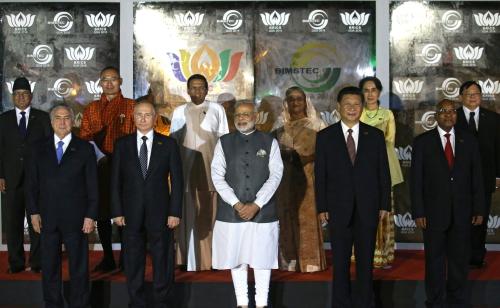Content from the Brookings Institution India Center is now archived. After seven years of an impactful partnership, as of September 11, 2020, Brookings India is now the Centre for Social and Economic Progress, an independent public policy institution based in India.
This article first appeared in The Print. The views are of the author(s).
Diplomats and foreign policy experts are puzzled by the absence of a “big announcement” or a major breakthrough from the fourth summit of the Bay of Bengal Initiative for Multi-Sectoral Technical and Economic Cooperation (BIMSTEC). How will Prime Minister Narendra Modi claim victory from a bland declaration?
Sometimes, no news is good news, especially when it is time for consolidation. As one of the world’s weakest organisations, the last thing the BIMSTEC needed was another set of empty promises, especially from India, which had committed to reviving the organisation in 2016 but has not always performed accordingly. So, quite paradoxically, while the declaration’s focus on institutional reform may not make for great news headlines or diplomatic cables, it attests to Delhi’s new pragmatism and consciousness about its own limitations.
After Modi promised to revive the BIMSTEC, holding an outreach summit with the BRICS leaders, in 2016, I spent a year researching this regional organisation. Delhi was then talking big about BIMSTEC, but nobody bothered to look at how that long and ugly acronym looked in practice, on the ground.
With fourteen working groups, BIMSTEC is mandated to increase infrastructure connectivity, implement a free trade agreement, and execute several conventions on legal cooperation, increase security coordination and intelligence sharing.
Headquartered in Dhaka since 2014, I discovered a weak and neglected institution, severely understaffed and underfunded. Bereft of the most basic capabilities to implement even a fraction of its increasing mandate, BIMSTEC was simply unable to respond to the sudden spurt of interest and expectations.
For two long years, BIMSTEC was burdened with every possible vision under the Bay of Bengal sun. With fourteen working groups, BIMSTEC is mandated to increase infrastructure connectivity, implement a free trade agreement, and execute several conventions on legal cooperation, increase security coordination and intelligence sharing. The wide range of issues covered also includes cooperation on energy, fisheries, agriculture, health, culture and tourism.
Last week’s declaration marks a departure from this dispersion because it finally includes a series of commitments to strengthen the organisation’s human, financial and technical capacity. By devoting 13 out of 18 points on BIMSTEC’s functioning, and a specific subheading on “institutional reform,” the leaders emphasised the “importance of robust institutional arrangements to effectively steering the process of regional cooperation under BIMSTEC”.
The declaration includes various steps in that direction. The creation of a new BIMSTEC charter will set out and clarify the organisation’s mandate, objectives and structure. The announcement of a new Permanent Working Committee has been an old demand from the secretariat and will play an important role to coordinate with member-states. The new BIMSTEC Development Fund (BDF) will allow member-states to focus and invest in their specific “pet projects”, in effect overriding the consensus clause and allowing for a multi-speed organisation. The declaration also vows to expand the secretariat’s supporting manpower, from the current level of three to seven directors, one from each member-state.
Most importantly, the leaders seem to be inclined to accept Thailand’s concept paper on the reprioritisation of BIMSTEC’s fourteen pillars of cooperation and focus instead on just five critical areas: connectivity, trade and investment, people-to-people contacts, security and disaster preparedness, and science and technology.
Finally, following the logic of continuity and implementation, the leaders directed their officials to conclude several pending agreements, including on coastal shipping and motor vehicles. They also set up four inter-governmental expert groups to develop cooperation frameworks on disaster management, climate change, and on the potential of linking the region’s mountains and blue economies. These are key initiatives to reconnect and revive the Bay of Bengal region.
After two years of flying the BIMSTEC flag, India seems to have realised that its investment in a more integrated Bay of Bengal region will depend on a stronger multilateral organisation.
The summit thus focused on consolidating – and possibly even reducing – BIMSTEC’s wide mandate and conversely increasing efforts to strengthen its institutional capacity to translate the leaders’ vision into practice. After two years of flying the BIMSTEC flag, India seems to have realised that its investment in a more integrated Bay of Bengal region will depend on a stronger multilateral organisation.
India’s BIMSTEC experience may also signal a subtler shift in its foreign policy momentum, now more conscious of its capacity limitations to deliver on the many bold commitments Prime Minister Modi made to the neighbourhood since 2014. Regional organisations aren’t built in a day. They require significant investment and continued commitment from its member-states. Leaders will show up at summits and make their lofty speeches, but it is with the bureaucracy that the implementation buck eventually stops.
Last week’s summit marks a positive step, reflecting a more pragmatic India that realises both the strength and limitations of BIMSTEC and is willing to empower the institution to finalise several pending initiatives, rather than burdening it with new promises.
The Brookings Institution is committed to quality, independence, and impact.
We are supported by a diverse array of funders. In line with our values and policies, each Brookings publication represents the sole views of its author(s).





Commentary
Op-edIndia attempts to empower BIMSTEC after realising its limitations
September 11, 2018